

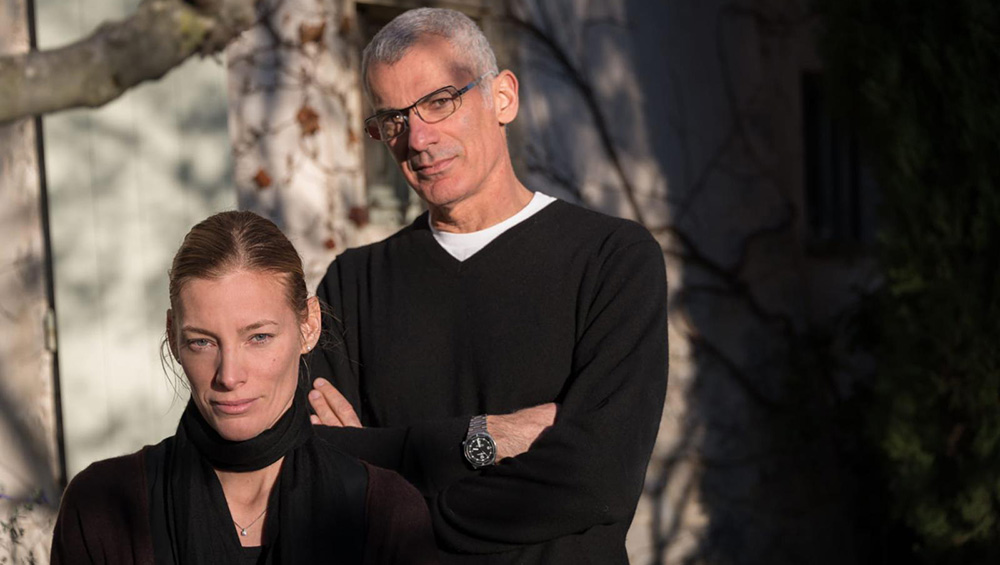
Zoé Ouvrier and Arik Levy. © Photo: Nelo Hagen, 2019.
by ANNA McNAY
Arik Levy (b1963, Tel Aviv) and Zoé Ouvrier (b1975, Montpellier, France) create works inspired by nature, but they do not simply attempt to interpret what they see; rather, they go beyond this, exploring, in Levy’s case, psychological and material polarities, and, in Ouvrier’s, feelings, emotions and narratives. Beyond Nature, then, is an appropriate title for this first exhibition bringing together the married couple’s works, and they are as excited as anyone to see what new conversations will arise as a result.
Levy and Ouvrier spoke to Studio International via Zoom from their new home and studio in Saint-Paul-de-Vence, France.
Anna McNay: Beyond Nature, at Method & Concept, Naples, Florida, is your first joint exhibition. Your works, on the surface, are quite different. What do you see as the common thread uniting your practices or finished pieces?
Arik Levy: Actually, we are showing at the same time in the same space, but each of us is carrying his own shadow in a way. But there are definitely common points. We both look at nature in very different ways. The best thing we do together is kids – and that works pretty well! But in terms of the work itself, I see it rather more that when somebody walks into the space, he will not necessarily see the common thread, but he will feel that there is some kind of connection. We definitely influence each other in many ways – some we know about and many we don’t. I will hear Zoé speaking about her work with somebody, and that will influence me, and vice versa, and then we will end up looking at the same thing at the same time, but interpreting it in a completely different way. But the fact that we live together, spend time together, vacation together, and so on and so forth, some of our experiences are necessarily similar within their context, but not in terms of the way we perceive them and look at and react to the world.
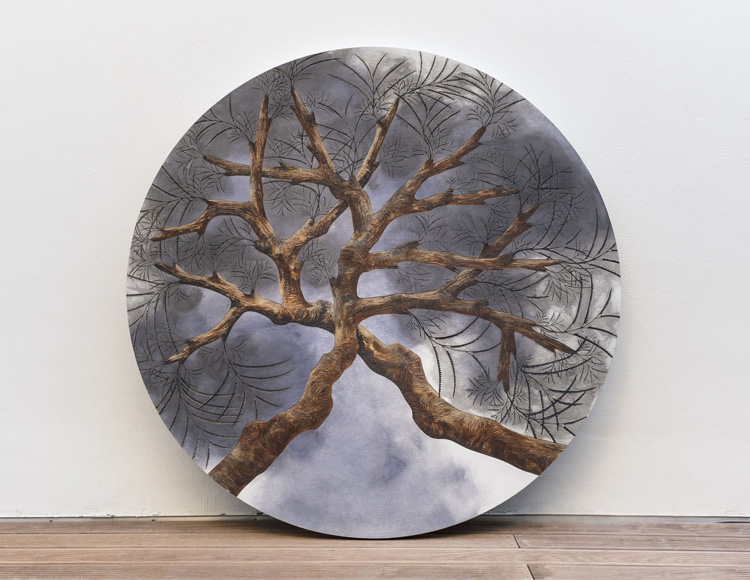
Zoé Ouvrier. Windy, 2017. Sculpture, acrylic, oil paint, 145 cm. Courtesy of the artist and Method & Concept.
AMc: Do you share a studio space?
Zoé Ouvrier: Yes.
AMc: Do you give each other feedback on your work?
AL: Yes, we just moved into this new place in Saint-Paul-de-Vence in France, which has a very big studio that used to be a dance studio. Finally, we have a decent studio, which is not at a great distance from our house, which is very practical – also dangerous, but practical. So we kind of split it, except there isn’t a real split. Ninety-nine per cent of the time Zoé will walk through my work and say: “What is this?” with a huge frown, and I will go to hers and say: “Wow, that is so great!”
ZO: [shakes her head and frowns]
AMc: It looks like Zoé disagrees!
AL: We definitely comment and give feedback. Even a frown is good feedback because it will make me think, or her think, about why the work is perceived in that way. I think we most appreciate the subconscious feedback, though, rather than the conscious feedback.
ZO: Exactly.
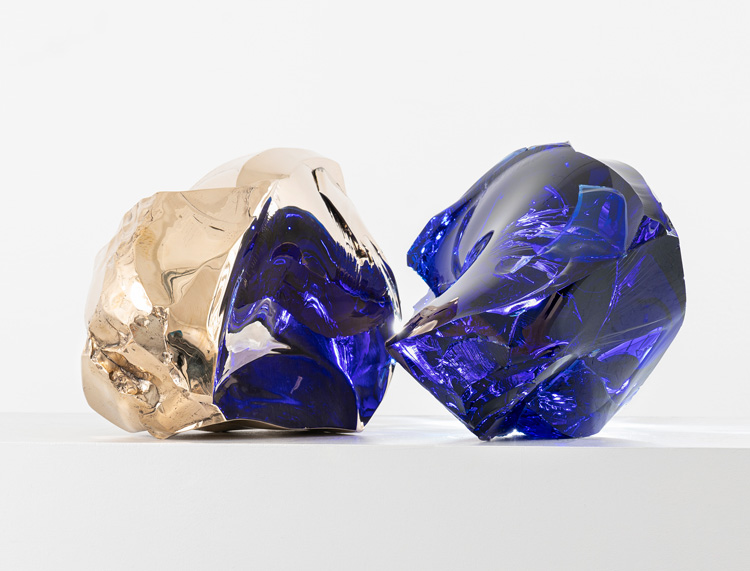
Arik Levy. Glass Block Reflection 34. Mirror, polished bronze and glass, each L25 x W 22.5 x H 34 cm, 7.5 Kg (bronze), 19 Kg (glass). Courtesy of the artist and Method & Concept.
AMc: You have mentioned nature already, and the title of the exhibition is Beyond Nature. Can you elaborate a little on what you mean by that?
AL: The reason for the title Beyond Nature is the fact that we are not direct interpreters of nature; there are many great artists whose interpretation of nature is very direct. If you take the impressionists, for example, they just drew the landscape. Van Gogh drew the sunflowers. It was their form of photography. We don’t do that. If you were to put Zoé’s work outdoors, you would see by juxtaposition that her trees are not trees, they just have nuances of what a tree is. The mind of the viewer connects to that subject matter, but it isn’t really a tree, and you cannot say: ‘Oh, that’s a fruit tree or a cedar or an oak.’ And it’s the same for me with my rocks. If you put our work indoors, it calls nature, it brings nature indoors. That is common to both of our work. You see the tree, you see the rock, you see the minerals, you see spring, you see autumn through the falling leaves, you see life … When you put our work outdoors, however, by juxtaposition you see that it has nothing to do – or not a lot to do – with the imitation of nature, and that is where it becomes interesting, because my personal interest – and Zoé will speak for herself – is that the work should only be a springboard for thoughts, which are nothing to do with the work itself. I am a provider of a springboard for the imagination and the interpretation of what one sees. What do you think, Zoé?
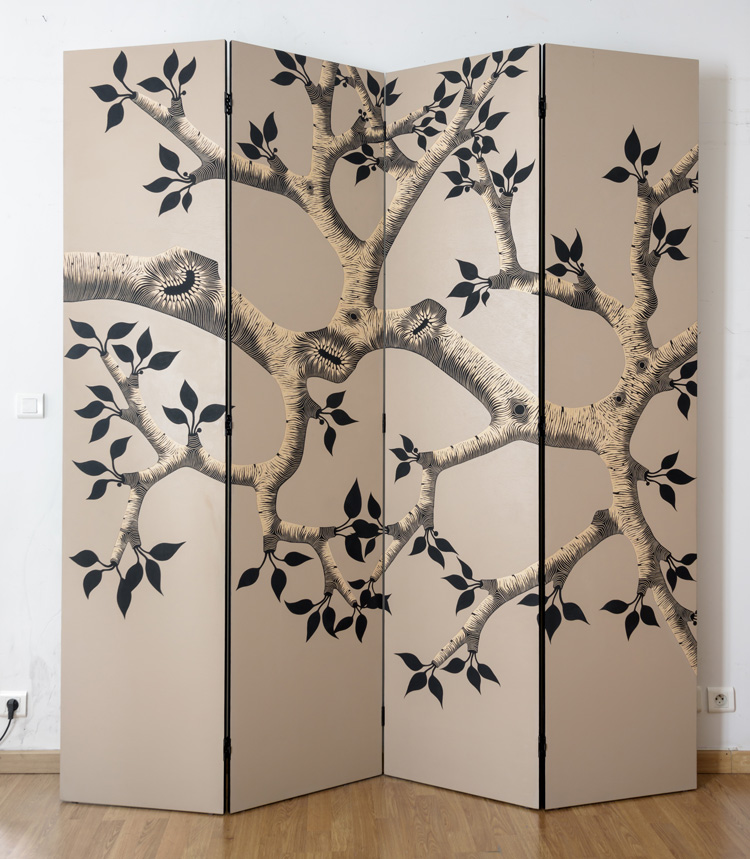
Zoé Ouvrier. Van, 2010. Sculpture, acrylic paint, H230 x W200 cm. Courtesy of the artist and Method & Concept.
ZO: Yes, completely. This is how I feel about life, love, respect for nature, animals … Maybe my work gives an opportunity for people to come back to nature, because we take from nature, everything we eat comes from nature, but we don’t show nature any respect any more. Now we are living with technology, but nature is coming back to us and reminding us that we cannot live without it. We need to fix the situation and show more respect for nature again.
AL: We consume, but we don’t fertilise.
AMc: That’s very true. Zoé, Arik was saying that your work isn’t trees, but, very literally, it is trees, because you are using wood and then creating trees out of trees.
ZO: Exactly. Initially, I really wanted to give back to nature what humans had taken. I used industrial panels – plywood – and tried to give the wood back its life and its beauty.
AL: Because it’s killed, it’s industrialised, it’s stripped, it’s glued, it’s compressed … It’s been subjected to every mechanical action that suppresses any feeling. So she took that hardly breathing, nearly dead, or already dead substance and gave it back its life. But it’s paradoxical, also, in the sense that she’s using chisels, wood chisels, which are actually cutting the wood. By cutting, she gives life, which is a contradiction. Cutting is taking away – and so she gives life by subtraction, which means that she reduces everything that is not necessary to get the essence to appear.
ZO: And the action of engraving necessitates taking off the skin, going beneath the skin, and you can play with that, and explain the story. The story might be about your torment, your scars … It’s through repetition and redundancy that we improve and see things differently.
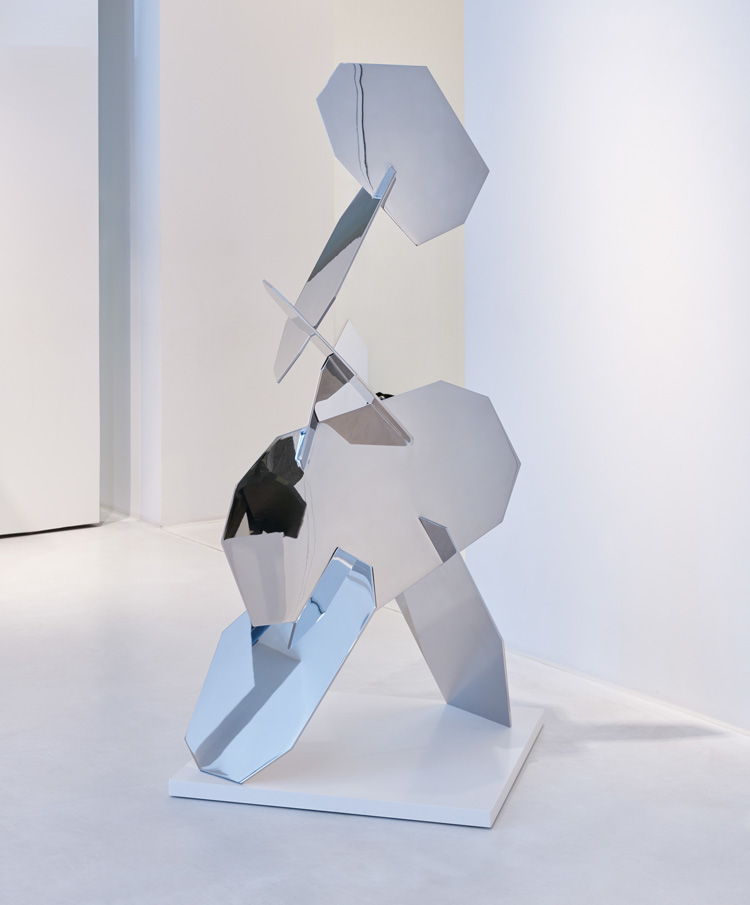
Arik Levy. Facet Formation 180. Mirror-polished stainlesss teelStandard Dimensions: L76 x W78 x H180 cm 93 Kg. Courtesy of the artist and Method & Concept.
AMc: Can you say a bit more about the stories? Is there a strong narrative element to your work?
ZO: Within every work there is a story that comes out, but it only reveals itself once the work is finished.
AL: It’s the opposite for my work, because, when I start, most of the time I know what I’m going to do, because I have to cut the metal. I can’t just cut it any old way and try to do something; it has to be cut in the correct way. So I discover in the process before making, and Zoé discovers in the process of making. But very often we both finish with something that we did not expect, but we have to learn to live with it. Just producing art is different – printing, for example – but making art is something that you have to experience. Sometimes there is work that we don’t want to sell, or we don’t want to show. But the most interesting works are those which I see as being part of a phase of transition, when we discover new things and innovate. We want to do something new, and this new thing has to grow on us, or we have to grow on it. When we were working on Zoé’s book, she said: “I am making monsters. I want to have a chapter of monsters.” I said: “What monsters?” And she showed me some of the wood knots and how they looked like a monster, depending on the way in which they were displayed. Or they could look like the feminine sex, or represent the torture of nature into its new lifeforms. There are interpretations that are only discovered with time, or when we see work again after a number of years – maybe pieces that have been bought that we re-see – we see ourselves in a different way.
Because of Covid, we have been unable to go to the gallery to install the exhibition, so they made a selection of works, and we talked about it and agreed on it, but they will install it by themselves, which, for us, is both unusual and frightening at the same time. It’s also great, though, because we will get a fresh look at ourselves, and I’m actually very intrigued to see how they want to play with the juxtaposition of our work.
ZO: It’s not really the narrative, I think it’s more the message I want to give. I live and grow with this message; it’s with me all the time. I’m from the countryside, and I have artist parents, in the theatre …
AL: French hippies!
ZO: It’s true, I am growing with the message – it’s about my life, my friends, my kids, what I’m feeling in the moment … I can listen to the radio and be influenced by what I hear. I’m influenced by what I have inside me, by where I’m from, by what’s happening around me. I think my work can interpret and tell the story. My work is always about love, about sensuality, about nature …
AL: All this with a knife!
ZO: Yes, all this with a knife!
AL: Our psychotherapist loves us!
ZO: I feel my breath, I feel free or not free. That’s why I use the silhouette of the tree, to look beneath the skin. It’s interesting to me when a collector buys a work and displays it in his living room. I always wonder what it is he wants to say to his friends. For me, it’s about what I feel, and how I can communicate this, and how my work can express this.
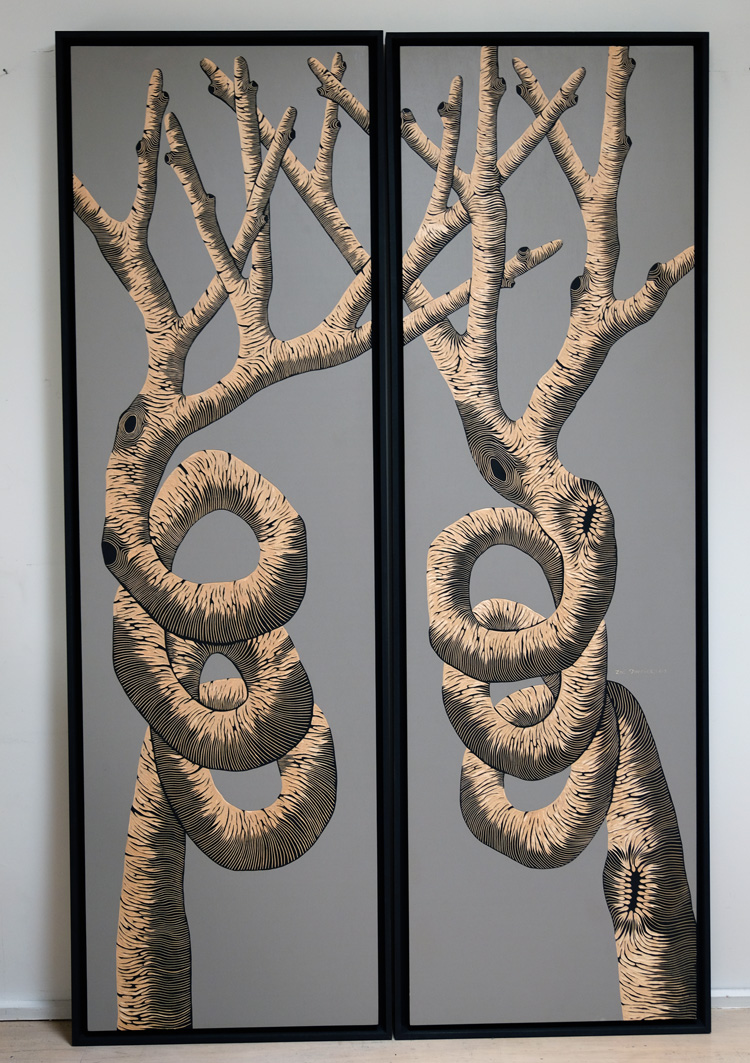
Zoé Ouvrier. Maguy, 2013. Sculpture, acrylic paint, H200 x W120 cm. Private collection. Courtesy of the artist and Method & Concept.
AL: We have done some other small things together, but we have never done such an exhibition together. So even this discussion, thanks to you, is an experience for us. We hear each other speaking about our work and each other’s work, and it is part of the exchange. I always think that a gallery is a space that has more oxygen than anywhere else because it’s a space without walls, somehow; it’s a space that expands, and it gives us the opportunity to do things that we have not done before, and in that way we both enter a new space of expression at the same time.
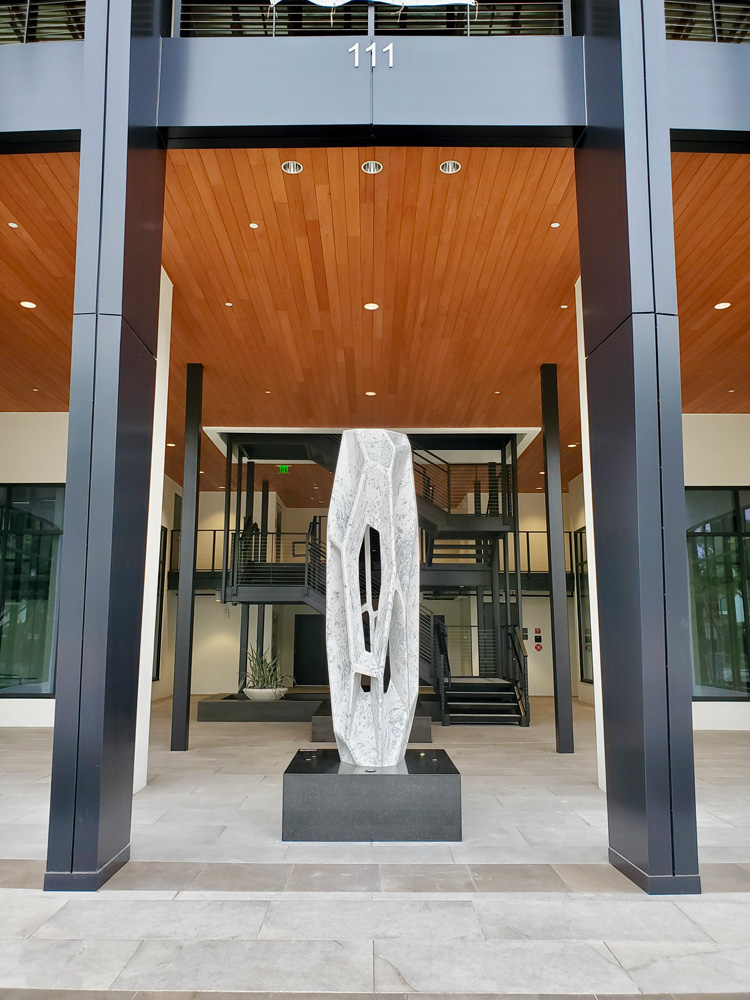
Arik Levi. Craterstone296. Marble. Courtesy of the artist and Method & Concept.
AMc: Arik, coinciding with the exhibition will be the official dedication, on 12 November, of your permanent sculpture, Craterstone296, outside the entrance to Method & Concept. Can you say a little bit more about this?
AL: Craterstone is an interesting story. I had a solo show at the Baker Museum in Naples, Florida, three years ago, and Craterstone was supposed to be there with the other outdoor sculptures, but its manufacture was delayed. In the end, it arrived three days before Hurricane Irma devastated the whole of Florida. The museum was flooded, and my exhibition closed three days after it opened. It was a nightmare. After some time, I got connected with the gallery at Method & Concept, and they thought that it would be a good idea for Craterstone to be installed in this new space where they now are, in this new complex, which is like a mall for architects, designers and collectors. They presented Craterstone to the owners there, the real estate developers, and they loved it, and they bought it, and so it’s like coming round in a full circle, with Craterstone returning to Miami. And then Method & Concept thought it would be great to have a gallery space in the same location, and that was the beginning of the discussion about an exhibition. Then things got tied together with Zoé’s work. So it really is a sort of ongoing evolution. We don’t really know how it’s going to settle down, if it ever will, but we are happy it’s happening.
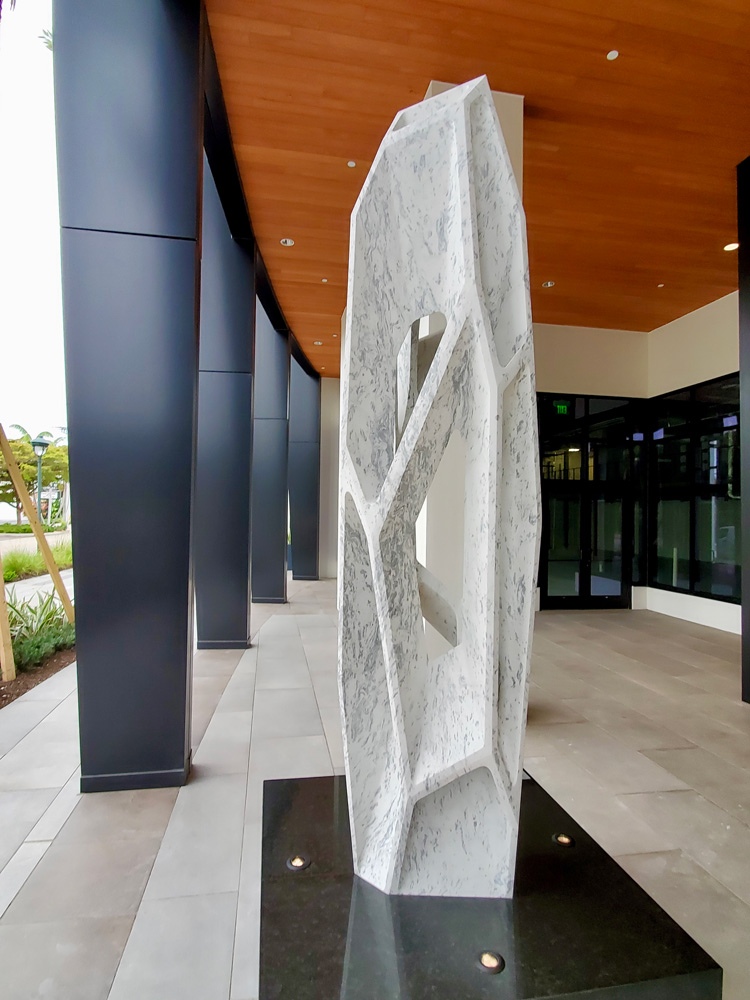
Arik Levi. Craterstone296. Marble. Courtesy of the artist and Method & Concept.
AMc: It seems a lot of your works, Arik, generally, play with oppositions, such as clear and opaque, melting and crystallisation. What attracts you to these poles?
AL: Yes, I don’t have a chronological trajectory to my work, because the subjects I work with now are the same ones I started with 15 years ago. The oppositions are between clear and unclear, solid and liquid, reflection and vision. It’s about seeing the world in a different way than with the human eye, or a camera, or an iPhone – in a way that technology could not put together, which is the beauty of the abstract.
AMc: Do you foresee that you would ever collaborate on a joint work, or is that not something you would want to do?
AL: As two artists under one roof, it’s not necessarily an easy thing to deliver, because artists have egos, we have strong personalities, we have strong opinions, which are not necessarily the same, and so it’s a case of constantly building bridges between us to be able to walk from one side to the other and meet somewhere in the middle. We have talked a lot about making works together, but it’s a pregnancy that hasn’t finished yet. But the insemination has happened.
AMc: Watch this space!
AL: Yes, we are cooking! The nicest thing is when somebody comes to see my work and falls in love with Zoé’s, or vice versa. There’s no competition between us. It’s an exciting moment in our separate lives and our joint life. This exhibition is a wonderful opportunity, and it’s one that joins our spirits and minds in one space. It will drive us in directions we haven’t driven in before.
• Beyond Nature is at Method & Concept, Naples, Florida, from 12 November 2020 to 5 February 2021.